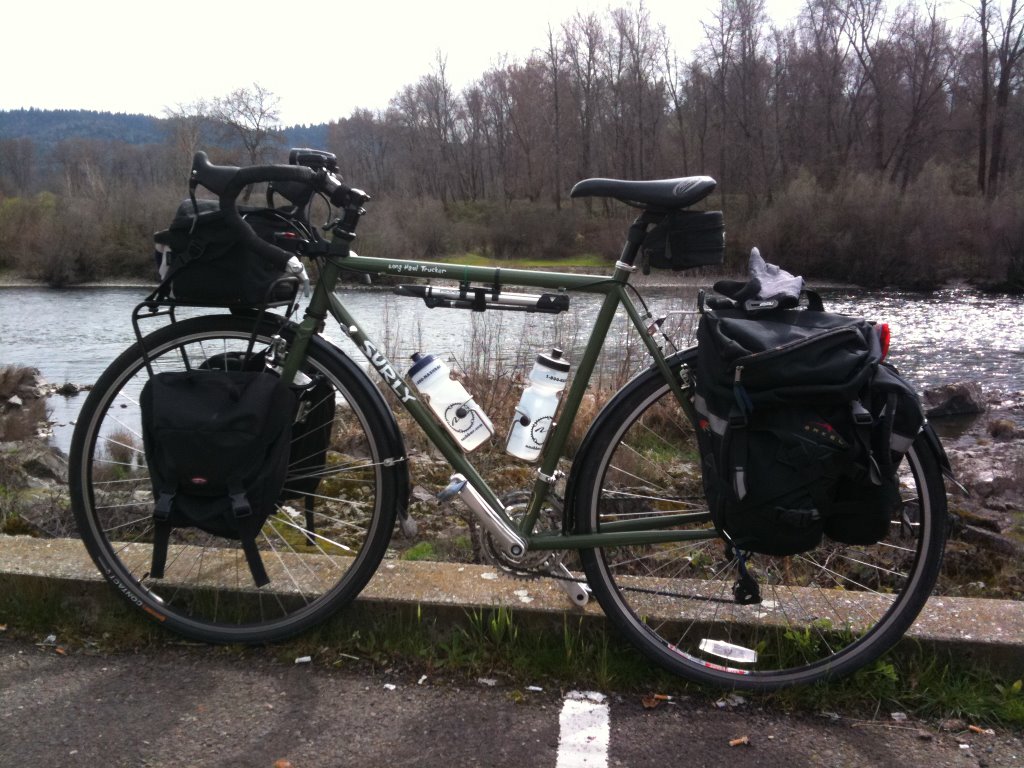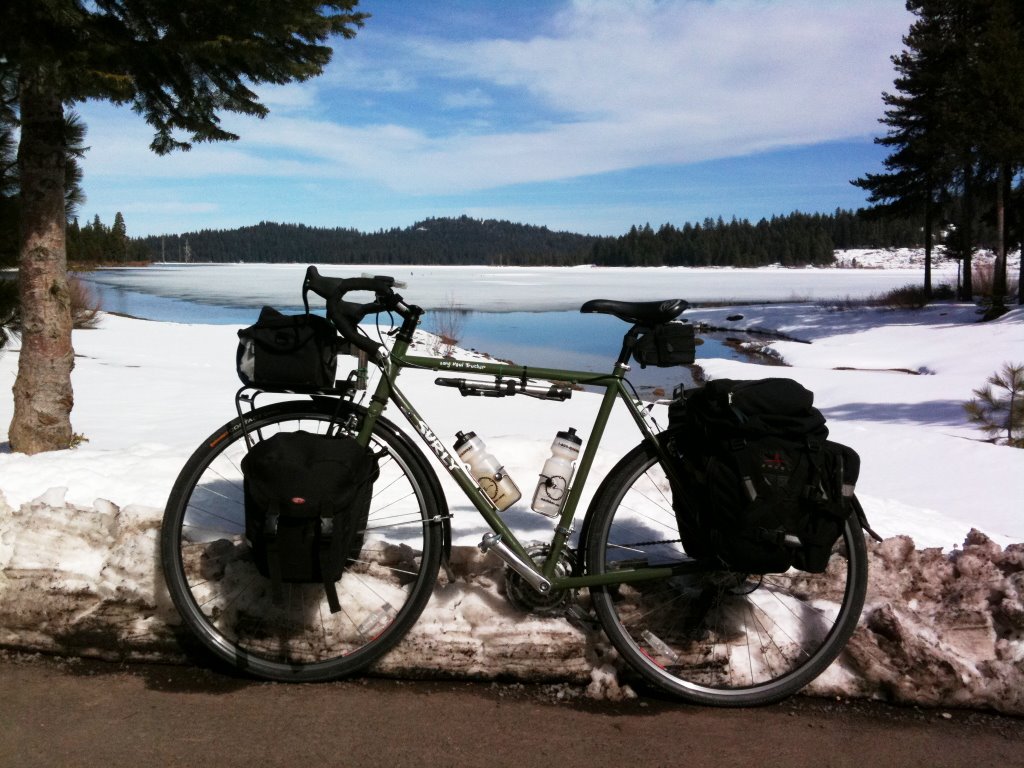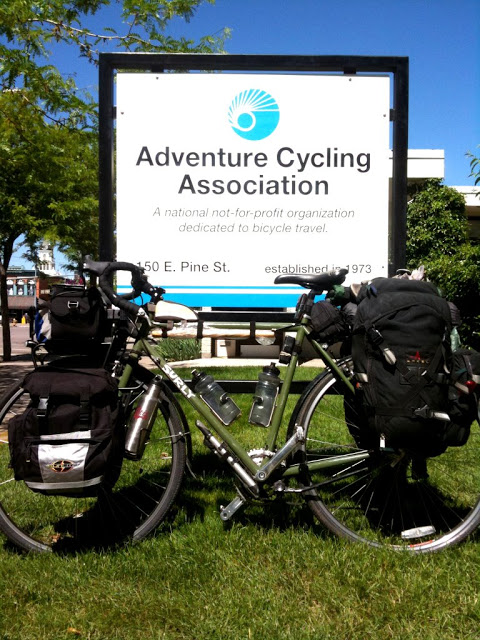The Surly Long Haul Trucker (a.k.a. LHT) is a popular bike built specifically for fully loaded touring. In this article I'll review some of the features of the LHT and how it compares with some other bikes.
Do you really need a "touring" bike?
So you're ready to start bicycle touring and wondering if you need to buy a new bike made specifically for touring. You might not. In fact you might already have the perfect bike. When I started out I used my mountain bike. Mountain bikes have nice low gearing, which you really need if you're carrying a heavy load over hills and mountains. In fact many older steel frame "hard tail" mountain bikes have very similar geometry to touring bikes. If you're planning on doing most of your riding on pavement you can put on narrower (1.25 - 1.6 inch) tires, but if you want to take in some gravel roads you might be fine just keeping your mountain bike tires. While I wouldn't recommend a full suspension mountain bike for touring, but a front suspension bike is fine. There are a number of front low-rider racks now available that fit front suspension bikes. So you may already have a good touring bike.
Road bikes on the other hand will generally not be geared low enough for touring, even those with triple chain rings. Modern light-weight carbon fiber road bikes are also not sturdy enough to support the weight of racks and gear. If you have an older steel frame road bike, it may be worth the cost of swapping out the drive train. This will generally consist of replacing the read derailleur and cassette with mountain bike parts. To get the same gearing as the LHT you'd also have to swap out the crank and chain rings.
In my case I really didn't have a good bike for the kind of touring I wanted to do, so I started looking into new, made-for-touring, bikes.
Why I got the Surly
The Surly Long Haul Trucker is one of the most popular touring bikes in the US. It's design is classic touring all the way from it's steel frame, to it's bar end shifters. It's designed to be sturdy, which of course makes it considerably heavier than your typical road bike. When I was shopping for this bike I looked at similar bikes from Trek, and Navaro (REI house brand). The problem with these other bikes was the gearing. They did not have the 48-36-26 chain rings coupled with the 11-34 rear cassette, which is what you need to ride a loaded touring bike over the mountains we have here in the Pacific Northwest. There are other good alternatives like those from Salsa and Rivendell, or if you want to spend more the Koga-Miyata, or if you really want to spend more a custom bike from Bruce Gordon. I didn't look at any of these as I was sold on the LHT early on.
Components
I bought my LHT from a bike shop in Eugene, Oregon. I was a bit naive about how these were sold when I did, and learned some things later on. If you go to the Surly website you see that Surly sells both complete bikes and frames. I thought I was buying the complete bike as sold by Surly. It turns out that shops will just by frames from Surly and then spec out the components themselves. This is not necessarily a bad thing, but you might not get exactly the same components as Surly advertises. What I learned from this is that you're better off working with your local bike shop, to get the frame from Surly, and spec out your own components. In most cases you'll want Shimano XT style front and read derailleurs, 48-36-26 chain rings, and an 11-34 rear cassette. Some people have upgraded from the standard cantilever brakes that come on most of these, to mountain bike style V brakes. This is probably a really good idea as you ca never have too much breaking power when barreling down a mountain at 40+ MPH on a fully loaded bike.
Shifters
The standard build LHT comes with bar-end shifters. The logic behind this is that there are fewer moving parts and that they are sturdier and easier to fix than modern STI style shifters (the kind where the shift levers are integrated with the break levers). This may be true, and could be a real consideration when traveling in the more remote parts of the world. Here in the states you're never that far from a bike shop, and STI shifters are much more common these days. I like the bar-end shifters but there are a couple of disadvantages. One is that you have to take your hands away from the the handle bar to shift. The other is that if you stand up to power over a hill, and you're not in a low enough gear, you'll have to sit back down to shift, and loose a lot of momentum. This later point is not that big a deal with a loaded touring bike as you're not going to be powering over hills anyhow. If I were specing out my own parts today, I would probably opt for the STI shifters, but I am happy enough with the bar-end shifters.
Wheels and Tires
You can get a Long Haul Trucker with either 700c or 26 inch wheels. In years past the 26 inch wheels where only available on frame sizes 54 inch and under. In response to demand they started making the 26 inch wheels available in larger frame sizes, starting in 2009. People traveling especially in South America require the 26 inch wheels as 700c tires are just not available in most places. Since I expect to be doing most of my touring here in the states, I went with the 700c wheels. I'm glad I did. Last summer I met up with a fellow bike tourist riding an LHT with 26 inch tires. Going up the mountains we rode at the same pace. When we started down the other side we would both start our coasting. It was amazing how soon I would be way ahead of him just on extra ground covered by the bigger tires. I like the way they handle and corner better as well. Of course this is totally a personal choice. Another consideration would be the kind of roads you plan on riding. If you want to be able to do a lot of dirt or gravel roads you'll be happier with the 26's and good mountain bike tires. The nice thing about the LHT is that there is plenty of clearance for wide tires, even with fenders.
Racks and Fenders
The LHT comes with all the braze-ons and eyelets you need to easily mount your racks and fenders. There is even the mount point mid way up the front forks for your front rack. I initially put low rider racks on the front, but I wanted something with a platform over the tires like the rear rack. After shopping around I ended up with the Surly front rack. This has got to be the sturdiest, and heaviest, rack available. It was certainly over-kill for my needs but I am happy with it. For the rear I went with the Blackburn Expedition rack. It's also sturdy, but not quite as heavy as the Surly rack. I also put on the Planet Bike fenders. If you plan on doing ay touring where it rains, fenders are a good thing to have. They really help keep you, and your gear clean.
Ride Feel and Handling
When I first got the Trucker I did some rides unloaded and thought it handled well and felt good. Of course it didn't have the acceleration as my light weight road bike, but once you got up to cruising speed it seemed effortless to maintain the pace. But it wasn't until I did my first loaded ride that I really got to appreciate this bike. The LHT actually feels and handles better with a heavy load! This bike was born to tour. Of course, as with any touring bike, it is important to get your load well balanced, but if you do the LHT will roll straight and corner smooth and true.
Handling the Hills
As I've said, this is not a light bike, and as you can see in the picture above, I don't exactly pack light either, so you may be wondering how I got up the mountains. Most mountain bikes are geared even lower that the LHT, but I found this gearing worked just fine on paved roads with grades up to 8%. Of course this depends on your strength and conditioning, but my point is that I don't believe the extra weight is that much of an issue. Sure you'll ride slow up the mountains, all the better for enjoying the views.

The Trucker at the Rogue River.

The Trucker at Hyatt Lake before the thaw.

The Trucker loaded up with Mt. McLaughlin in the background, just getting started on my tour from Oregon to Montana.

The Trucker in front of ACA headquarters in Missoula, Montana.